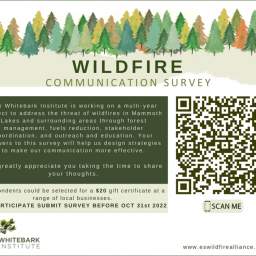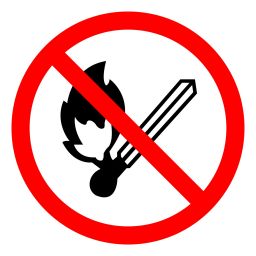
Fire in the Eastern Sierra
The forests of the Sierra Nevada have undergone a transformation over the last century due to human fire suppression. Lightning strikes are common in the Sierra and historically brought low intensity fires that burned small trees, litter, and brush, creating open space for native grasses and wildflowers. Indigenous communities throughout the Sierra used fire to manage food production and encourage the growth of critical plants. In several locations in the Sierra fire is still used today by these communities. Today, public land managers and scientists are studying the role of fire in the Sierra and are committed to understanding how best to achieve fire restoration and protect our remaining healthy forests from catastrophic wildlife.

High intensity fires are occurring more regularly and are burning larger and hotter, threatening communities, wildlife, water quality, and other aspects of forest ecology. Ongoing smoke from these fires compromise the outdoor tourism economy and community health. These fires are a product of a changing climate, but also of many decades of fire suppression that was once thought among land managers to be necessary for the health of the forest. For various reasons, fire suppression in Eastern Sierra forests has only occurred for about 50-60 years, creating a window of opportunity for the Inyo National Forest to restore historic fire regimes if we can act quickly over the next decade.
We advocate to create fire-safe communities and increase community resiliency by increasing the pace and scale of fire restoration in the Eastern Sierra. The Inyo National Forest recognizes the need to restore fire and has recently been implementing prescribed fire and fuels treatments. However, to be ecologically meaningful, larger landscape level (500-1,000+ acres) burning must occur on a yearly basis with follow up treatments and monitoring. Ecological objectives for maintaining species diversity and evolutionary processes can only be met through the use of fire, either through managed wildland fire use or prescribed fire. Under the new Forest Plan, the Inyo has taken a bold step in the right direction by proposing a forest-wide prescribed burning and restoration program over the next decade. Friends of the Inyo fully supports this effort and is seeking to work with the Inyo through a collaboration of fire scientists and policy experts to achieve meaningful restoration goals linked to desired conditions in the Forest Plan. Friends of the Inyo will also help the Forest with public communication on the benefits of fire and living with smoke when burning conditions are favorable.
Take Action
Learn More
Learn more from this downloadable
presentation, Increasing the Pace and Scale
of Fuels Reduction and Forest Restoration in the
Sierra Nevada, by Malcolm North, et al.
(USFS PSW, USFS Region 5 and UC Berkeley)
Updates
English-Language Survey The Whitebark Institute of Interdisciplinary Environmental Sciences is working on a multi-year project to address the threat of wildfires in Mammoth Lakes and surrounding areas through forest management, fuels reduction, stakeholder coordination, and outreach and education. Whether you live in the Mammoth area or not, please help by answering the following survey (Spanish information follows the English) by scanning the QR code, or by clicking on the graphic or on the corresponding link provided. The survey will take less than 10 minutes to complete, but will be helpful in understanding the public’s level of wildfire awareness, as well…
ReadyforWildfire.org: CAL FIRE Tips for Strengthening Your Home Against Wildfires ¡En Español! AND in English! At the urging of Crystal Medhurst, Defensible Space Outreach Coordinator for Mammoth Lakes, Friends of the Inyo focused its latest Amigos de Nuestras Tierras (“Friends of Our Lands”) column in this week’s (Sept. 8 – 14) issue of local Spanish-language newspaper El Sol de la Sierra (ElSoldelaSierra.com) on the extremely useful life-and-death information from the CAL FIRE website, ReadyforWildfire.org, to help locals a) create a defensible space around their home, b) harden or strengthen their home against fire, and c) develop and emergency kit and…
Be informed: Please read the full news release about strict fire restrictions that take into account the fire danger created by dry conditions. Please comply with these restrictions from the U.S. Forest Service and Bureau of Land Management, and help us spread the word.
The latest issue of Friends of the Inyo’s Jeffrey Pine Journal, now in its twentieth year, features timely conservation-related topics such as fire management, wayward balloon litter in nature, the 30×30 Initiative to conserve 30 percent of our public lands and coastal waters by 2030, and more. Click on the image above or this link to access and download a pdf version. Happy reading! Please remember that you can get a hard copy of the Jeffrey Pine Journal delivered to your home twice a year, in Spring and Fall, as one of the perks of membership with Friends of the…
The USDA Forest Service Pacific Southwest Region will end the regional closure order affecting National Forests in California at 11:59 pm on Wednesday, Sept. 15, two days prior to the original end date of Sept. 17. However, forest-wide closures will remain in place and be extended until midnight on September 22nd on the Los Padres, Angeles, San Bernardino, and Cleveland National Forests in Southern California due to local weather and fire factors, as well as a temporary strain on firefighting resources supporting large fires in other areas of the state.
This article analyzes how wildfire behavior is changing with the Caldor and Dixie fires, and highlights how change in high elevation Sierra ecosystems may remove a historic buffer for wildfires. “What’s unique about both these fires is that the fires have burned up into very high elevation in the Sierra Nevada,” Clements said. “One reason that likely is the drought, lower snowpack . . . those higher elevations are drying out sooner, so, your fuel-moisture content in those plants are drier — and we predicted that in April that this was going to be the case.” read more…








